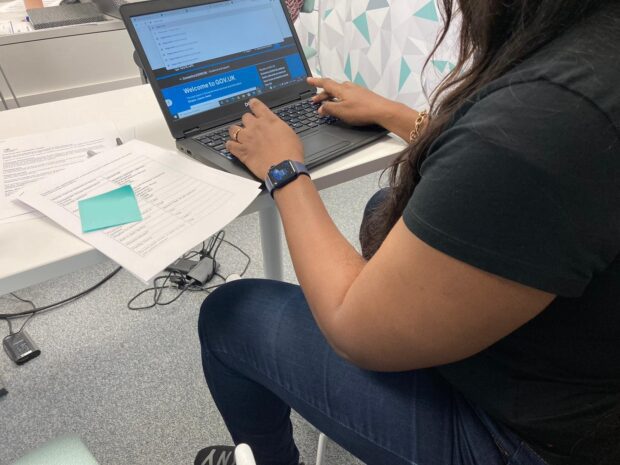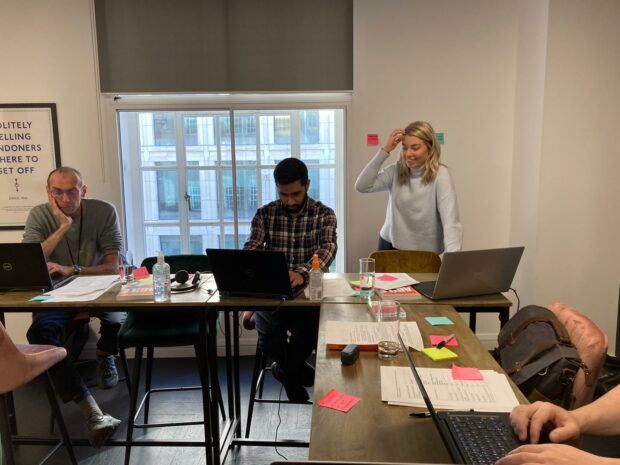UK Export Finance (UKEF) is on an exciting transformation journey. Across the organisation, we’re focusing on how to make our services simpler to use, more user-centred and accessible.
UKEF’s Digital Trade Finance Service (DTFS), now in beta, is being transformed so that it meets users' needs including those with access needs. The service allows banks to provide financial support to UK exporters by submitting an application on their behalf to UKEF, whose advisors process those applications.
The service is used by a handful of banks which means it is not always easy to recruit new users. This poses challenges when carrying out research as an authentic approach requires finding users with some understanding of the bank delegation system. This challenge is increased further when seeking to recruit those who have access needs.
Whilst accessibility testing has been carried out with proxy users (those who are not likely to use the service but have a good understanding of users of the service), testing must be very prescriptive. Participants are provided with all the information they would need to use the service and they are guided along a certain path. Whilst this method is still effective in gaining some valuable insights, it makes it tricky to learn about authentic paths of navigation.
Using the GDS accessibility personas
To support government services and meet the Service Standard in designing for accessibility, the Government Digital Service (GDS) has created 7 accessibility personas. These are 7 personas with different access needs which can be used to do some ‘persona testing’ on a service.

How we ran the walkthrough with the team
Whilst it would be impossible to replicate a user’s true experience through the personas, we adapted the workshop to focus on the following:
- gaining insights into the service’s accessibility
- creating greater empathy for users with different needs


We followed guidance on GitHub to simulate the conditions for the personas and install the assistive technology required. We used Chrome Browsers where most of the settings could be changed at the browser level and additional extensions were used where needed.
The challenge here was the order in which settings were changed. For example, one persona relies on the keyboard to navigate so a change in settings removed the cursor. Once the cursor disappeared, we struggled to complete some of the other changes. We had to rethink the order in which we changed the settings and this included bookmarking the service in advance, so that participants could access the service on their device.
We documented each step and created a checklist to record the changes. By tracking these we knew exactly which settings to revert at the end of each session. This, together with setting up the Chrome accounts for each persona in advance, was useful when we ran the workshop remotely and had to send participants instructions on how to set up their devices.
We ran 3 workshops in total with our team. Two in person at our User Researcher’s offices in London and 1 remotely. This meant we could involve all members of the team regardless of where they were located.


In-person vs. remote workshops
For the in-person workshops, it was a chance to meet after a long period of working remotely with many new starters never having met face to face. It was also a chance to use sticky notes again, interact and capture the energy in the room. We could witness reactions first-hand and set laptops up for the participants ahead of the workshop.
For the remote workshop, we factored in time for each participant to set their laptop up and all participants had high levels of digital confidence. As a result, we faced no delays caused by technical issues. The workshop allowed everyone to participate without the worry of being exposed to coronavirus (COVID-19). We used a simple collaboration tool to capture insights anonymously and this meant we didn’t spend time training participants.
Insights gained
Participants contributed many learnings on sticky notes or the online whiteboard tool we used. For example, the amount of white space on certain pages made it difficult for the user to see if there were further actions when using a screen magnifier and text from buttons were not consistently read aloud by a screen reader. We’ve created actions from these findings which we’re using to inform further research and testing.
Overall, participants were surprised by daily challenges experienced by users with different access needs. They were engaged in understanding which parts of the service could be improved to overcome access issues and recognised their responsibility in making the service simple, accessible and inclusive.
We found that the persona testing was a cost-effective way of engaging the wider team in the process and helped us continue to develop a service that meets the needs of all our users.
The DTFS Head of Digital Operations felt it was an effective way of engaging the team “and keeping accessibility at the forefront of everyone’s mind”. As a result, work continues to encourage adoption of this approach through senior stakeholders and with service teams throughout UKEF.
Find out more about how DTFS is showing what good looks like in beta and have a go at using the GDS accessibility personas with your team.


4 comments
Comment by content designer posted on
Wouldn't it be users *who* have accessibility needs? They are human beings, not things
Comment by viktoriawestphalen posted on
Our sincere apologies for this - we have updated the title and text to reflect this now.
Comment by Alan Rider posted on
Great blog post and accessibility is such an important topic that its great to see it in action.
Comment by Shane Lynch posted on
Great blog Clara - well done to all the DTFS team at UKEF.